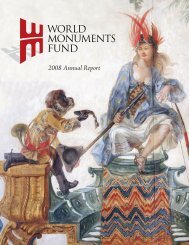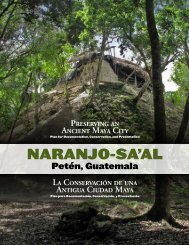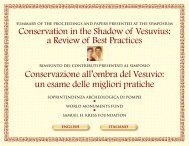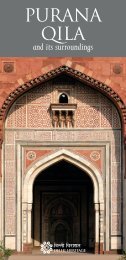Lodi Garden and the Golf Club (pdf) - World Monuments Fund
Lodi Garden and the Golf Club (pdf) - World Monuments Fund
Lodi Garden and the Golf Club (pdf) - World Monuments Fund
You also want an ePaper? Increase the reach of your titles
YUMPU automatically turns print PDFs into web optimized ePapers that Google loves.
The Delhi <strong>Golf</strong> <strong>Club</strong><br />
The Delhi <strong>Golf</strong> <strong>Club</strong> is one of <strong>the</strong> oldest golf courses in Delhi<br />
established by <strong>the</strong> British in 1930s. When Sir Edwin Lutyens was<br />
laying out New Delhi, a decision was taken to shift <strong>the</strong> golf course<br />
<strong>the</strong>n in use, which included <strong>the</strong> area now known as India Gate, to <strong>the</strong><br />
current location after a reconnaissance by <strong>the</strong> Chief of <strong>the</strong> Horticultural<br />
Department. Built on l<strong>and</strong> which was a burial ground of <strong>the</strong> Sultanate<br />
<strong>and</strong> Mughal dynasties, it integrates <strong>and</strong> adorns a slice of <strong>the</strong> city’s<br />
history within its lush lawns, sprawling across an area of 220 acres.<br />
Located in <strong>the</strong> heart of <strong>the</strong> city, bounded by five intersecting roads,<br />
namely Dr Zakir Hussain Marg, Lal Bahadur Shastri Road, <strong>Lodi</strong> Road,<br />
Archbishop Makarios Marg <strong>and</strong> Subramaniam Bharti Marg, <strong>the</strong> club<br />
is home to over 300 species of birds <strong>and</strong> a variety of nearly 200 trees<br />
amidst vast greens <strong>and</strong> ancient monuments.<br />
Originally located in an area twice its present size, <strong>the</strong> club has<br />
undergone many changes <strong>and</strong> was redesigned by Peter Thompson in<br />
1977–78. Access to <strong>the</strong> <strong>Golf</strong> <strong>Club</strong> is from Dr Zakir Hussain Marg,<br />
entering through which one can explore <strong>the</strong> structures inside,<br />
by moving from south to north, mostly along <strong>the</strong> peripheral boundary.<br />
The <strong>Golf</strong> Course today is only accessible to members or<br />
through a special permission.<br />
A few of <strong>the</strong> Mughal <strong>and</strong> Tughlaq tombs within <strong>the</strong> <strong>Golf</strong> <strong>Club</strong> were<br />
earlier part of a village named Babarpur, that was located towards<br />
<strong>the</strong> south of <strong>the</strong> current boundary of <strong>the</strong> <strong>Golf</strong> <strong>Club</strong>. Barah Khamba,<br />
an early Mughal tomb <strong>and</strong> <strong>the</strong> tomb of Bagichi are <strong>the</strong> tombs that<br />
originally belonged to this village. O<strong>the</strong>r Mughal constructions inside<br />
<strong>the</strong> <strong>Golf</strong> <strong>Club</strong> include <strong>the</strong> tomb of Sayyid Abid, Mir Taqi’s Tomb, Lal<br />
Bangla enclosure, <strong>and</strong> a few more unknown mosques <strong>and</strong> tombs. The<br />
Gol Gumbad (located outside <strong>the</strong> site along <strong>the</strong> <strong>Lodi</strong> Road) <strong>and</strong> Barah<br />
Khamba are <strong>the</strong> only Sultanate era constructions in <strong>the</strong> vicinity.<br />
Entry with prior permission only.<br />
Timings: 5.00 am – 11.00 pm (summer),<br />
6.00 am – 11.00 pm (winter)

















